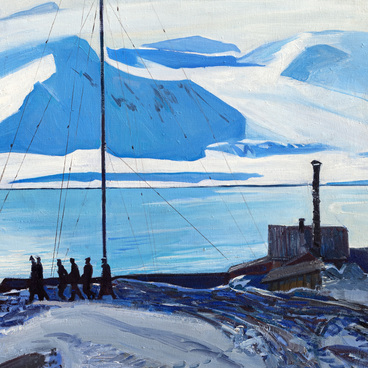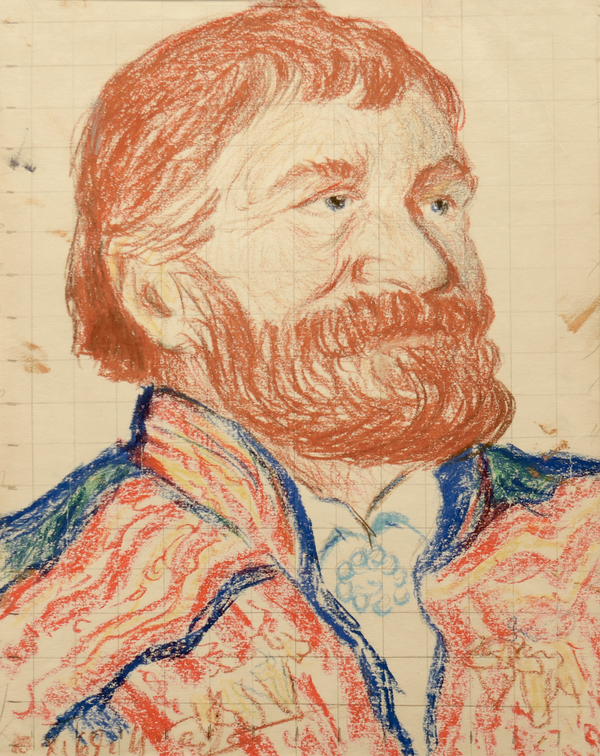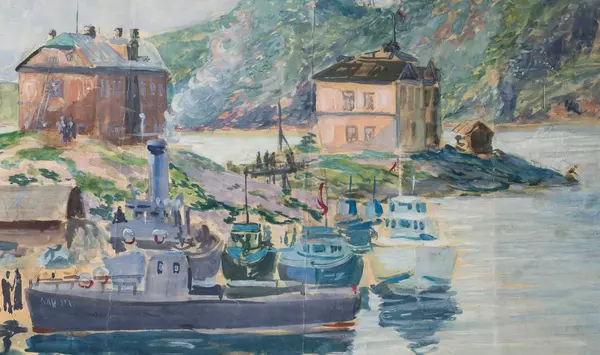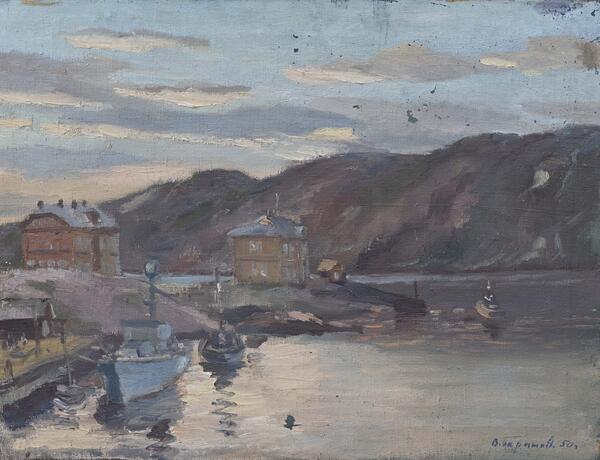Vasily Grigorievich Baranov was born in the Smolensk governorate in 1912. He graduated from the Leningrad Art and Pedagogical College in 1937. He was a member of the Union of Artists since 1961 and an Honored Worker of the RSFSR since 1976.
In 1937, Baranov served in the Northern Navy in the city of Polyarny. During the war years, Vasily Baranov served as a sailor, and then as a junior commander in Murmansk.
In 1965, the Murmansk branch of the Union of Artists of the USSR was established — it was headed by Vasily Grigorievich for many years.
The themes of the artist’s works are Murmansk in the war and post-war years, people who serve in the army in the difficult Northern conditions, the sea, and sketches of the harsh Arctic nature.
Vasily Grigorievich worked a lot in the genre of portraiture, both in painting and graphic art, creating psychologically accurate images of his contemporaries.
One of the examples is the “Portrait of the Finnish Artist Reidar Särestöniemi”. The Finnish artist Reidar Särestöniemi was of Sami descent. He was born on May 14, 1925 into a farmer’s family in the village of Kaukonen, Kittilä municipality in Finnish Lapland. He studied at the school of the Finnish Academy of Fine Arts in Helsinki and at the Leningrad Institute of Painting, Sculpture and Architecture named after I.E. Repin.
Särestöniemi’s work was influenced by European modernism, Russian art and cave art, but the main source of inspiration for the Lapland artist was the harsh Arctic nature and the people of the North. That is why the artist is often called “the shaman of the North” and “the Lapland hermit”. In the paintings of this extraordinary person, nature is rendered as a world full of secrets and spirits.
In this portrait, Reidar is a smiling man wearing national Sami clothing with an decorative pattern on his chest and shoulders, and a light-colored brooch at the collar of his undershirt. Portraying his close friend and colleague, Vasily Baranov is fascinated by the brightness of the Sami costume, the combination of blue, white and red. The large figure of Reidar Särestöniemi makes a marked contrast with the fragile northern birch trees in the background of the painting. The harmonious rhythm of light and dark blue shades creates a harmonious composition.
In 1937, Baranov served in the Northern Navy in the city of Polyarny. During the war years, Vasily Baranov served as a sailor, and then as a junior commander in Murmansk.
In 1965, the Murmansk branch of the Union of Artists of the USSR was established — it was headed by Vasily Grigorievich for many years.
The themes of the artist’s works are Murmansk in the war and post-war years, people who serve in the army in the difficult Northern conditions, the sea, and sketches of the harsh Arctic nature.
Vasily Grigorievich worked a lot in the genre of portraiture, both in painting and graphic art, creating psychologically accurate images of his contemporaries.
One of the examples is the “Portrait of the Finnish Artist Reidar Särestöniemi”. The Finnish artist Reidar Särestöniemi was of Sami descent. He was born on May 14, 1925 into a farmer’s family in the village of Kaukonen, Kittilä municipality in Finnish Lapland. He studied at the school of the Finnish Academy of Fine Arts in Helsinki and at the Leningrad Institute of Painting, Sculpture and Architecture named after I.E. Repin.
Särestöniemi’s work was influenced by European modernism, Russian art and cave art, but the main source of inspiration for the Lapland artist was the harsh Arctic nature and the people of the North. That is why the artist is often called “the shaman of the North” and “the Lapland hermit”. In the paintings of this extraordinary person, nature is rendered as a world full of secrets and spirits.
In this portrait, Reidar is a smiling man wearing national Sami clothing with an decorative pattern on his chest and shoulders, and a light-colored brooch at the collar of his undershirt. Portraying his close friend and colleague, Vasily Baranov is fascinated by the brightness of the Sami costume, the combination of blue, white and red. The large figure of Reidar Särestöniemi makes a marked contrast with the fragile northern birch trees in the background of the painting. The harmonious rhythm of light and dark blue shades creates a harmonious composition.







